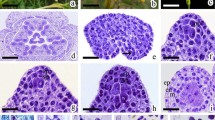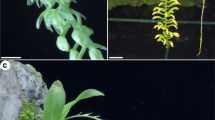Abstract
Comparative embryology ofEchinochloa colonum (Linn.) Link andEchinochloa crusgalli (Linn.) Beauv. is described. The anther wall comprises the epidermis, fibrous endothecium, a middle layer and uniseriate glandular tapetum. Microspore tetrads are isobilateral inEchinochloa crusgalli but they may occasionally be linear, T-shaped, decussate or intermediate besides being isobilateral inEchinochloa colonum. The hemianatropous ovule is pseudocrassinucellate and bitegmic. Embryo sac development conforms to the monosporic, Polygonum type. Endosperm development is nuclear. The development of the embryo is irregular and characterised by the formation of diagonal cell walls in the quadrant and octant proembryo. Both the integuments as well as the nucellus degenerate in mature caryopsis. The mature embryo is about half the length of the caryopsis and is of the panicoid type. The results have been discussed in light of the earlier work onEchinochloa and other members belonging to the tribe Paniceae.
Similar content being viewed by others
References
Bhanwra R K and Choda S P 1981 Comparative embryology of some grasses belonging to the tribes Aveneae, Brachypodieae, Bromeae, Festuceae and Phalarideae; inContemp. Trends in Plant Sciences (New Delhi: Kalyani Publishers) pp 254–262
Bhanwra R K, Choda S P and Kumar S 1982 Comparative embryology of some grasses;Proc. Indian Nat. Sci. Acad. B48 152–162
Bhanwra R K, Choda S P and Kumar R 1985 Comparative embryology ofBrachiaria ramosa andPoa annua;Res. Bull. Panjab Univ. Sci. 36 245–253
Bhanwra R K and Soni D V 1986 The mode of reproduction inOplismenus burmanii, O. compositus andPaspalum distichum; Proc. Indian Nat. Sci. Acad. (in press)
Gould F W 1968Grass systematics (New York: McGraw-Hill)
Maheshwari P 1950An Introduction to the Embryology of Angiosperms (New York: McGraw-Hill)
Muniyamma M 1978 Variation in microsporogenesis and the development of embryo sac inEchinochloa stagnina (Retz.) P. Beauv. (Gramineae);Bot. Gaz. 130 87–94
Narayanaswami S 1953 The structure and development of caryopsis in some Indian millets. 1.Pennisetum typhoideum;Phytomorphology 3 98–112
Narayanaswami S 1954 The structure and development of caryopsis in some Indian millets. 2.Paspalum scrobiculatum;Bull. Torrey Bot. Club 81 288–299
Narayanaswami S 1955a The structure and development of caryopsis in some Indian millets. 3.Panicum miliare andP. miliaceum;Lloydia 18 61–73
Narayanaswami S 1955b The structure and development of caryopsis in some Indian millets. 4.Echinochloa frumentacea;Phytomorphology 5 161–171
Narayanaswami S 1956 The structure and development of caryopsis in some Indian millets. 6.Setaria italica;Bot. Gaz. 118 112–122
Author information
Authors and Affiliations
Rights and permissions
About this article
Cite this article
Bhanwra, R.K., Choda, S.P. Comparative embryology ofEchinochloa colonum andEchinochloa crusgalli (Poaceae). Proc. Indian Acad. Sci. 96, 71–78 (1986). https://doi.org/10.1007/BF03053273
Issue Date:
DOI: https://doi.org/10.1007/BF03053273




